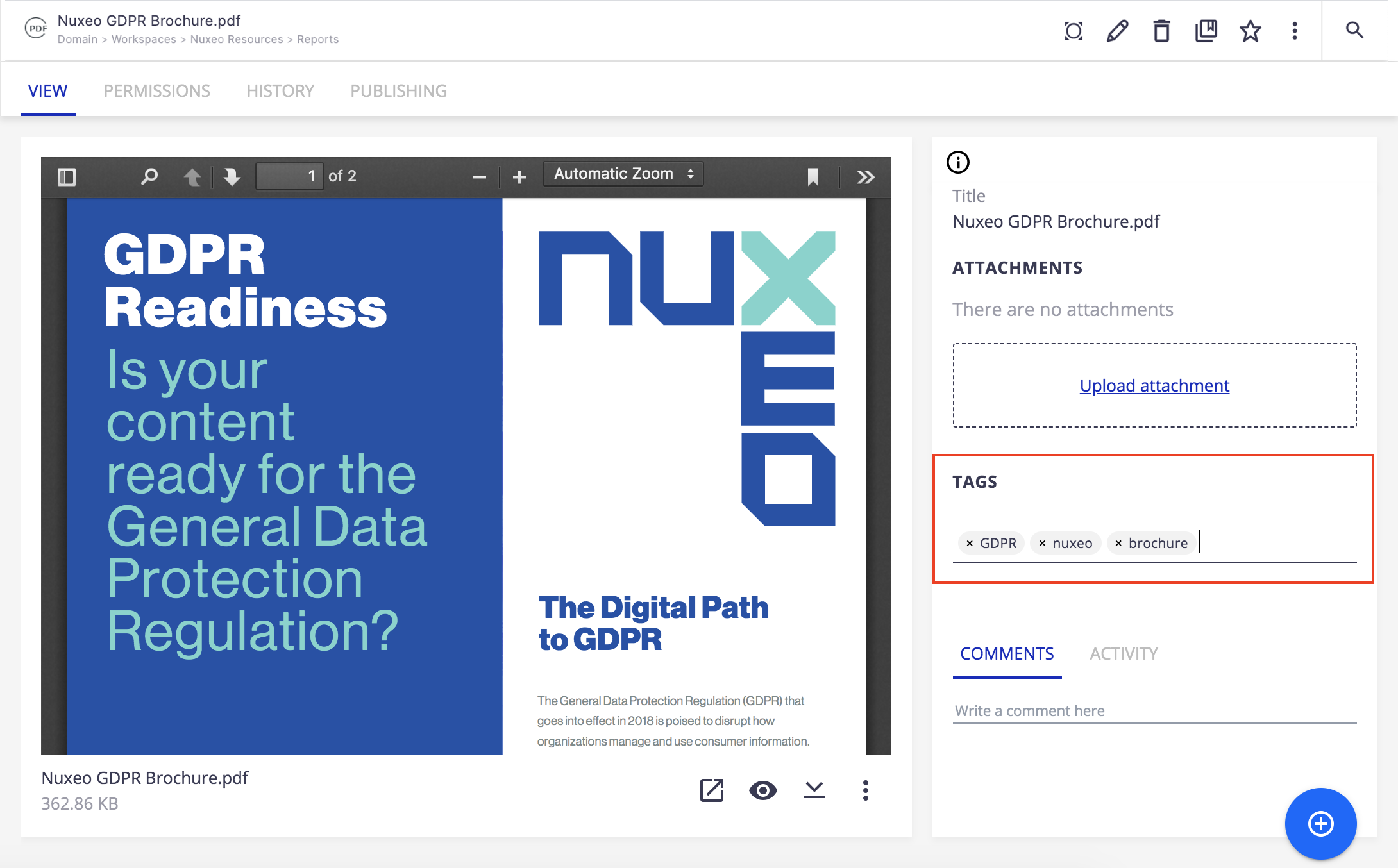The tags are either categorizing the content of the document (labels like document_management, ECM, complex_Web_application, etc., can be thought as tags for Nuxeo), or they reflect the user feeling (great, user_friendly, versatile, etc.).
The tag service uses two important concepts: a tag object, and a tagging action. Both are represented as Nuxeo documents.
A tagging action is a link between a given document and a tag, and belongs to a given user. A tag holds a label that does not contain any:
- space
- slash
- backslash
- percent
- quote
Characters will be removed by service.
Functional Overview
Unlike subjects in the metadata of the document, you don't have to choose tags in a closed list. You are free to apply the tags that describe the document best. However, tags are proposed as you type them, to enable you to use the same tags as the other users and have a consistent tagging of documents. You can add as many tags on a document as you want.


Users can add a tag on a document as soon as they can access the document, i.e. as soon as they have reading permissions.
To tag a document, go to the View tab of the document and type the label you want to add in the Tags field.
Click on the suggested label to add an existing tag or on the tag with a + to create and add a new one.
The tag is immediately added on the document and available in the Search tab to let you search by tags.


To remove a tag, you need to be the user who added the tag on the document or have at least Edit permission on the document. Click on the icon ![]() , the tag is immediately removed.
, the tag is immediately removed.
Tags, Versions and Publication
When you save a document as a new version, the tags that user have put on the document are saved with the version. This means that the archived versions of a document and the document in its current version can have different tags. If you restore a previous version of the document, tags are restored with it and replace the tags from the replaced version.
When you publish a document, the tags are copied from the work document to the published document. You can then remove useless tags from either version of the document (work version or published version) without affecting the other one. In case of republication of the document, the tags from the last and previous version are merged so you don't loose any previous or preparatory categorization.
Tag Service Architecture
The following document types are defined by the tag service.
A Tag is a document type representing the tag itself (but not its association to specific documents). It contains the usual dublincore schema, and in addition has a specific tag schema containing a tag:label string field.
A Tagging is a relation type representing the action of tagging a given document with a tag. (A relation type is a document type extending the default Relation document type; it works like a normal document type except that it's not found by NXQL queries on Document). The important fields of a Tagging document are relation:source which is the document id, relation:target which is the tag id, and dc:creator which is the user doing the tagging action.
Both Tag and Tagging documents managed by the tag service are unfiled, which means that they don't have a parent folder. They are therefore not visible in the normal tree of documents; only queries can find them. In addition they don't have any ACLs set on them, which means that only a superuser (and the tag service internal code) can access them.
Tag Service Features
The tag service is accessed through the TagService interface.
The tag service allows you to:
- Tag and untag a document
- Get all the tags for a document
- Get all the documents for a tag
- Get the tag cloud for a set of documents
- Get suggested tags for a given tag prefix
Tags, Versions and Proxies
The tags are duplicated:
- From the live document when creating a version
- From a version when creating a proxy
When restoring a version, the tags on the live document are also restored from the ones on the version.
Tags can be added and removed independently on live documents, versions and proxies: a tag added on a live document won't be added on all its versions, but only on the versions that will be created after. The same behavior is applied for proxies.
The logic for the above is in the TaggedVersionListener listener.
Disabling Tags on Versions and Proxies
To disable the duplication of tags on versions and proxies, the TaggedVersionListener may be disabled with the following contribution:
<require>org.nuxeo.ecm.platform.tag.service.listener</require>
<extension target="org.nuxeo.ecm.core.event.EventServiceComponent" point="listener">
<listener name="taggedVersionListener" enabled="false" />
</extension>